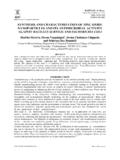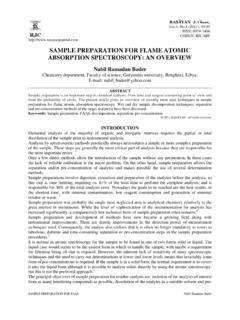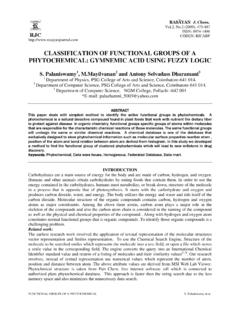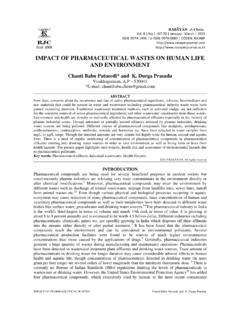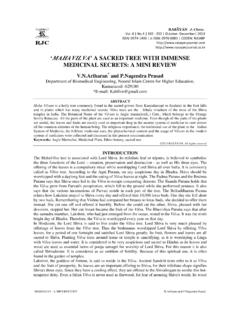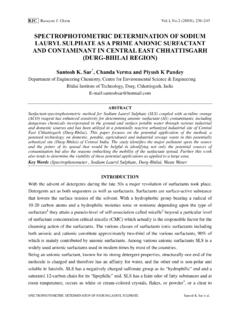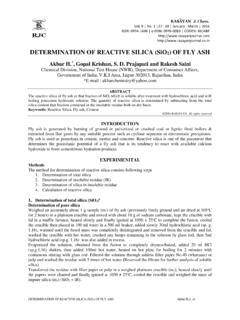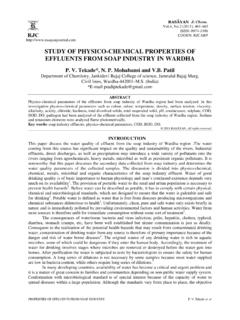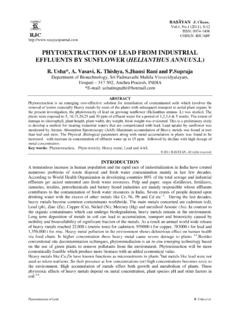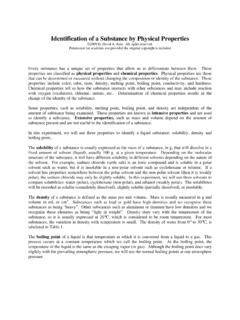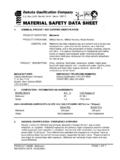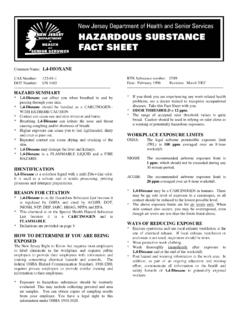Transcription of IDENTIFICATION, ISOLATION AND CHARACTERIZATION OF ...
1 Vol. 6 | | 324 - 333 | October- December| 2013. ISSN: 0974-1496 | e-ISSN: 0976-0083 | CODEN: RJCABP. identification , ISOLATION AND CHARACTERIZATION . OF POTENTIAL DEGRADATION PRODUCT IN IDEBENONE. DRUG SUBSTANCE. , Rao2* and Rao2. 1. Analytical Research, Custom Pharmaceutical Services, Dr. Reddy's Laboratories Ltd. Bollaram Road, Miyapur, Hyderabad, 500049, India 2. Andhra University, Visakhapatnam-530 003, India *. E-Mail: ABSTRACT. In the stress degradation studies of Idebenone, one major unknown base degradation impurity was identified by LC- MS. This impurity was isolated using preparative high performance liquid chromatography. Based on the spectral data (1H NMR, 13C NMR, DEPT, MS, HR-MS and IR), this degradation impurity is characterized as 2-hydroxy-5- (10-hydroxydecyl)-3-methoxy-6-methylcycl ohexa-2,5-diene-1, details of stress studies, identification , ISOLATION , CHARACTERIZATION , formation and mechanism of this impurity is discussed and presented in detail.
2 Keywords: Idebenone, Degradation, Potential degradation product, identification , ISOLATION , CHARACTERIZATION . 2013 RAS YAN. All rights reserved INTRODUCTION. Idebenone, 2-(10-hydroxydecyl)-5,6-dimethoxy-3-meth ylcyclohexa-2,5-diene-1,4-dione belongs to quinone family. It is a powerful antioxidant and an analog of ubiquinone which is most commonly used antioxidant drug1-2. Idebenone is used for Alzheimer disease, liver disease, heart diseases and a number of inherited disorders including Leber's disease (an eye condition), mitochondrial encephalomyopathy (nerve and muscle disorders) and Friedreich's ataxia (heart disease and diabetes)3-8. Unlike vitamin and botanical antioxidants, Idebenone is a respiratory chain drug and is reported to correct the signs of aging and also offers the highest protection against harmful environmental free radical stress.
3 Its Environmental Protection Factor (EPF) is 95, the highest rating of all antioxidants tested9. Idebenone enhances long-term potentiation in hippocampal nerve cells, a key part of memory formation and consolidation. Idebenone reaches the tissues more easily than ubiquinone and efficiently protect cells from peroxidative damage due to the modification of the composition and length of its side chain. Idebenone was developed from benzoquinone derivatives in the research laboratories of Takeda Chemical Industries, Ltd., and widely used in Japan to treat mental symptoms associated with old age and cerebrovascular disease10. Amit and Francis developed UV-Spectrophotometric methods for the determination of Idebenone in bulk drug and formulations11-12.
4 Rathi developed a validated a stability-indicating HPTLC method for the determination of Idebenone in bulk drug13. Several analytical methods have been reported for Idebenone in the bulk drug and formulations using HPLC14-17. Hu developed LC-MS. method for the determination of Idebenone in plasma18. To the best of our knowledge there are no reports on the CHARACTERIZATION of degradation products of Idebenone in literature. The present research work describes the identification , ISOLATION and CHARACTERIZATION of major unknown degradation product formed during the base degradation studies19. EXPERIMENTAL. Chemicals and Reagents The investigated samples of Idebenone were received from Process Research Department of Custom Pharmaceutical Services of Dr.
5 Reddy's Laboratories Limited, Hyderabad, India. The chemicals used in the present analysis are Trifluoroaceticacid (Across), sodium hydroxide (Rankem), hydrochloric acid DEGRADATION PRODUCT IN IDEBENONE DRUG et. al Vol. 6 | | 324 - 333 | October- December| 2013. (Rankem), hydrogenperoxide ( Fine Chemicals) and HPLC-grade acetonitrile (Rankem). Water used in the analysis and ISOLATION was purified using Milli-Q plus purification system. Instrumentation High-performance liquid chromatography An Agilent 1100 series HPLC with photodiode array detector with chemstation data handling system was used. The analysis was carried out on Zorbax SB C18 column with 150mm length, internal diameter and m particle size. Mobile phase A was water and trifluoroacetic acid in the ratio of 100 (v/v) and mobile phase B was acetonitrile and trifluoroaceticacid in the ratio of 100 (v/v).
6 UV detection was carried out at 215 nm and flow rate was kept at mL/min. Column oven temperature was maintained at 40 C. The gradient program: time/% of MP-B was 0/40, 25/90, 30/90, 31/40 with post run time 5 min. O7 8 O7. 8 14 16 18 20 24 3 4 13 15 17 19 21 23. 9 O 3 4 22 9 O OH. OH 5. 2 5 15 2. 17 19 21 23 14 16 18 20 22. 10 O 6 13 HO 6. 1 1 12. O 10 O. 11 11. 12. Idebenone Degradation product O OH. OCH3 O O O. H3CO. O. O. O. H3CO CH3 O. Impurity-1 Impurity-2 Impurity-3. OH OH. O O O OH. O. O O. Impurity-4 Impurity-5. : Chemical structures of Idebenone and impurities High-performance liquid chromatography (preparative). An Agilent 1100 series preparative liquid chromatography equipped with a photodiode array detector system was used. Data was processed through chemstation software.
7 Zorbax SB C18 (250mm long . ) preparative column packed with 5 m particle size was employed for ISOLATION of the impurity. Mobile phase A was water and trifluoroacetic acid in the ratio of 100 (v/v) and mobile phase B was acetonitrile and trifluoroacetic acid in the ratio of 100 (v/v). The flow rate was kept at 20 mL/min and the UV detection was carried out at 215 nm. The gradient program employed with T (min)/ % mobile phase-B (v/v) as 0/40, 14/70, 16/90, 19/90, 20/40 with post run time of 5 min. DEGRADATION PRODUCT IN IDEBENONE DRUG 325 et. al Vol. 6 | | 324 - 333 | October- December| 2013. LC-MS. LC-MS was carried out on the degraded drug substance of Idebenone. The mobile phase used was water : trifluoroacetic acid in the ratio of 100 (v/v) as a mobile phase -A and acetonitrile: trifluoroacetic acid in the ratio of 100 (v/v) as a mobile phase - B using the following gradient/elution (T/%B: 0/40, 25/90, 30/90, 31/40) flow rate of mL/min and monitored at 215 nm.
8 A Zorbax SB C18 column (150mm , with a particle size of m) was used. The injected volume was 10 L. Nitrogen as nebulizer gas and as collision assisted dissociation gas was used with Capillary voltage 4000V and collision energy 25V. Source gas temperature at 325 C and flow rate at 12 lit/min was used. The data were processed using Mass hunter software. High resolution mass Samples were analyzed on the Micromass LCT Premier mass spectrometer equipped with an ESI. Lockspray source for accurate mass values. Leucine enkephalin was used as internal reference compound which was introduced via the Lockspray channel using the Waters reagent manager. The mass range was calibrated with the cluster ions of sodium formate using a fifth order polynomial fit.
9 The data were acquired in W mode using the Mass Lynx software. The mass spectrometer was equipped with a Waters Acquity system. The conditions were used for the analysis are as follows- Water: trifluoroacetic acid in the ratio of 100 (v/v) as a mobile phase -A and acetonitrile: trifluoroacetic acid in the ratio of 100 (v/v) as a mobile phase-B was used. The gradient/elution (T/%B: 0/40, 25/90, 30/90, 31/40), flow rate of mL/min and detection at 215 nm was used. A Zorbax SB C18 column (150mm , with a particle size of m) was used. Impurity was dissolved in water: acetonitrile (50:50 v/v) diluent at a concentration level of mg/ mL. The positive electrospray data were obtained by capillary voltage 2400 V, cone voltage 70V, cone gas 50 L/min, source temperature 125 C, desolvation temperature 250 C and desolvation gas flow 450 L/h.
10 NMR spectroscopy The NMR spectra for Idebenone and degradation product were recorded on Varian Mercury plus 400. MHz and Gemini 200 MHz (Gemini-2000) spectrometers (Varian, Germany) in CDCl3 solvent. The 1H. chemical shift values were reported on the scale in ppm, relative to TMS ( = ), while 13C. chemical shift values were reported relative to CDCl3 ( = ppm) as internal standards. Distortionless enhancement by polarization transfer (DEPT) spectral editing revealed the presence of methyl and methyne groups as positive peaks while the methylenes as negative peaks. The data were processed using Linux software. Table -1: NMR assignments of Idebenone and Degradation product _____. Position1 Idebenone Degradation product _____ _____. 1. H (ppm) 2J 13.
